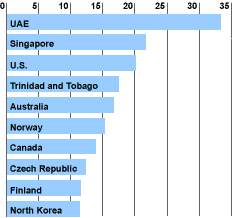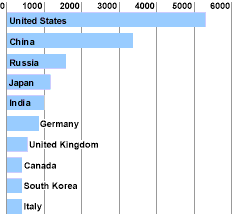
Population and Climate Change
Date
November 1, 2000
Author
(November 2000) International negotiations aimed at ameliorating climate change have generally focused on consumption patterns in industrialized countries rather than global population growth. Industrialized countries have produced the bulk of greenhouse gas emissions to date: The United States alone accounted for 23 percent of total world CO2 emissions in 1996, according to the U.S. Department of Energy’s Carbon Dioxide Information Analysis Center (CDIAC). The staggering levels of emissions in more developed countries stem mainly from consumption patterns that lead to high per capita emissions (see Figure 1). In 1996, U.S. per capita emissions of carbon dioxide stood at 20.0 metric tons, while for Germany and Japan the figures were 10.5 and 9.3 metric tons, respectively. In contrast, the global average for that year was 4.0 metric tons per capita. For sub-Saharan Africa, it was 0.8 metric tons.
Figure 1
Per Capita Carbon Dioxide Emissions, Top Ten Countries, 1996 (metric tons)

Source: U.S. Department of Energy, Carbon Dioxide Information Analysis Center, published in the World Bank’s World Development Indicators 2000.
The developing world is fast becoming a substantial contributor to climate change, however. With economies and populations in less developed countries growing considerably, so are their levels of greenhouse gas emissions. In China, emissions of carbon dioxide rose from 1.5 to 2.8 metric tons per capita between 1980 and 1996, while the population increased from 984 million to 1.22 billion. As a result, China accounted for 15 percent of the world’s total emissions in 1996, second only to the United States (see Figure 2). Less developed countries altogether accounted for 23 percent of worldwide emissions in 1996, as opposed to under 17 percent in 1980.
In the long run, efforts to curb climate change will have to address both consumption patterns that contribute to high per capita emissions as well as the growing number of consumers worldwide. To involve less developed countries in the solution, future climate change agreements are likely reflect the view that people of the world enjoy equal rights to use the atmosphere to dispose of the carbon generated by fossil fuel combustion. If adopted, such a principle would make the overall size of the human population a critical variable. The larger the population becomes, the lower the average per capita level of emissions commensurate with acceptable levels of greenhouse gas production. In other words, as population grows, each individual’s right to pollute shrinks.
Figure 2
Total Carbon Dioxide Emissions: Top Ten Countries, 1996 (million metric tons)

Source: U.S. Department of Energy, Carbon Dioxide Information Analysis Center, published in the World Bank’s World Development Indicators 2000.
Population growth also increases the number of people who will be affected by climate change, though it remains unclear how specific communities will be affected. In addition to rising temperatures and changing weather patterns, a number of less obvious effects could occur. Agricultural productivity might be boosted in some areas, but disrupted in others, worsening malnutrition. Global warming could also lead to a redistribution of disease-carrying insects, introducing unaccustomed human populations to such diseases as malaria, dengue fever, yellow fever, and encephalitis.
The Intergovernmental Panel on Climate Change has identified Africa as the continent that is most vulnerable to the impacts of the projected changes because widespread poverty limits adaptation capabilities. But other regions will be affected as well. Countries with large coastal populations — China, India, and the United States, for example — may have to contend with extensive damage from rising sea levels. In countries that are susceptible to flooding such as Bangladesh, more severe storms and changing rainfall patterns could exacerbate existing problems, endangering communities that already live on vulnerable land. In the end, there will no doubt be additional, unanticipated effects: The full range of climate change’s impact remains to be seen.
Bingham Kennedy, Jr. is an associate editor at the Population Reference Bureau.
